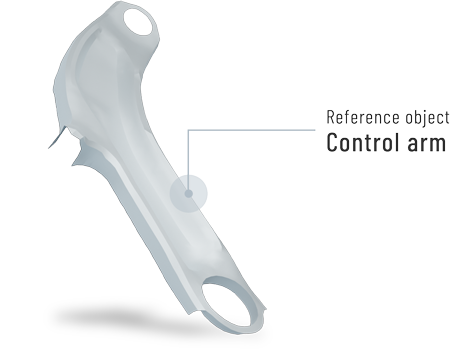Partnering for transformation
"The world is changing; climate protection has become a task for society as a whole. National, international politics has set a clear course. We, Salzgitter AG, are rising to the challenge of CO2 reduction, we see it as an opportunity and place it at the center of our actions. This takes courage, courage towards change towards sustainable production processes, sustainable solutions and products - together with our customers."
Gunnar Groebler, Chief Executive Officer
Scenario
As part of a study by Salzgitter Mannesmann Forschung, a steel handlebar concept was conceived, designed and evaluated as an alternative to an aluminum forged handlebar. The result shows interesting advantages in terms of costs and environmental balance - with an acceptable additional weight.
Vehicle emissions
Vehicle emissions per 100 km: gCO2eq/kmEmissions steel production
CO2 Emissions production (Steel handlebar): kgCO2eqEmissions aluminum production
CO2 Emissionen Produktion (Aluminiumlenker): kgCO2eq
This tool was developed by our experts for life cycle analysis. The data originates mainly from the database of the LCA for Experts software from Sphera (https://sphera.com/life-cycle-assessment-lca-software/). They have been carefully researched and selected. Nevertheless, deviations may result that have a positive or negative influence on the life cycle assessment of the component, so that one concept (steel/aluminum) appears better or worse. The tool is therefore not intended for a quantitative component assessment, but merely to visualize and clarify the most important influences such as the material used and the type of drive. We will be happy to answer any specific questions you may have.
Green Steel
Green Steel Classification System
The steel industry has embarked on the path towards climate neutrality. In addition to the major but technologically feasible challenges, there is the question of how a "green" steel that is more expensive to produce can find its way into application.
This is where the political instrument of "green lead markets" comes into play. Lead markets for climate-friendly products are a key component in supporting the transformation and represent an important bridge until climate-neutral raw materials have become fully established on the market. However, green lead markets can only develop in Europe if they are based on clear definitions, standardized certification rules and transparent classifications of processes and products. This requires an industry-wide coordinated set of rules that is internationally compatible.
The Steel Federation of Germany, together with its member companies and the BMWK, presented a corresponding draft in Berlin in November 2023 as the basis for a voluntary labeling system for CO2-reduced steel. Steel products are classified according to their greenhouse gas intensity and scrap rate here. This will enable customers to compare manufacturing processes and products transparently and reliably.
With the so-called "sliding scale" approach described above, the steel industry is taking account of the fact that the availability of steel scrap is limited worldwide and that a more climate-friendly classification should not be achieved solely through the increased use of steel scrap.
Sustainable future
SALCOS®
Together with partners from industry and research, we have laid the foundations for virtually CO2-free steel production with SALCOS®. The aim of the program is to avoid climate-damaging CO2 emissions in the production of primary steel (CDA: Carbon Direct Avoidance). Instead of using fossil coking coal in the classic blast furnace, the iron ore is freed from oxygen in a direct reduction plant using green hydrogen, i.e. reduced. The hydrogen for this is produced by water electrolysis using green electricity. The directly reduced solid iron (DRI) obtained in this way is then melted in an electric arc furnace and processed further in the conventional way. Instead of climate-damaging CO2, only harmless water vapor is emitted.
As a result, we can avoid 95% of our previous CO2 emissions via conventional primary steel production.
Circularity
Recycling strategy
Scrap already plays an important role in steel production today. The recycling rate of steel is almost 100%. Today scrap is either used to produce secondary steel or a fixed percentage is used in primary steel production for process-related reasons. The switch to electric arc furnaces in the SALCOS® route changes the significance of scrap for our primary steel production. In future, scrap can be melted together with DRI in the electric arc furnace to produce steel grades with a variable scrap content. This will enable us to achieve an even lower CO2 footprint. We are aiming for a product range from 0 to 60 % scrap content.
Another driver
Carbon Border Adjustment Mechanism (CBAM)
The Carbon Border Adjustment Mechanism (CBAM) is part of the European Union's (EU) "Fit for 55" package. A primary goal of this package is to reduce greenhouse gas emissions in the EU by at least 55% by 2030. The European Emissions Trading System (EU ETS) is a key EU climate protection instrument. Companies have to purchase emission allowances for the greenhouse gases they emit.
Companies can now choose to relocate their production to countries with less ambitious climate protection targets to avoid the costs of emission allowances. In order to reduce the incentives to relocate production, particularly emission-intensive companies have so far been given a portion of the emission allowances free of charge. The free allocation will be gradually phased out by 2034 as planned. The CBAM system is now intended to counteract the competitive disadvantages in the EU ETS by aligning the costs of imported goods with goods produced in the EU. To this end, a compensation payment should be made for the import of certain emission-intensive products into the EU, which takes into account the difference in CO2 costs compared to production within the EU.










